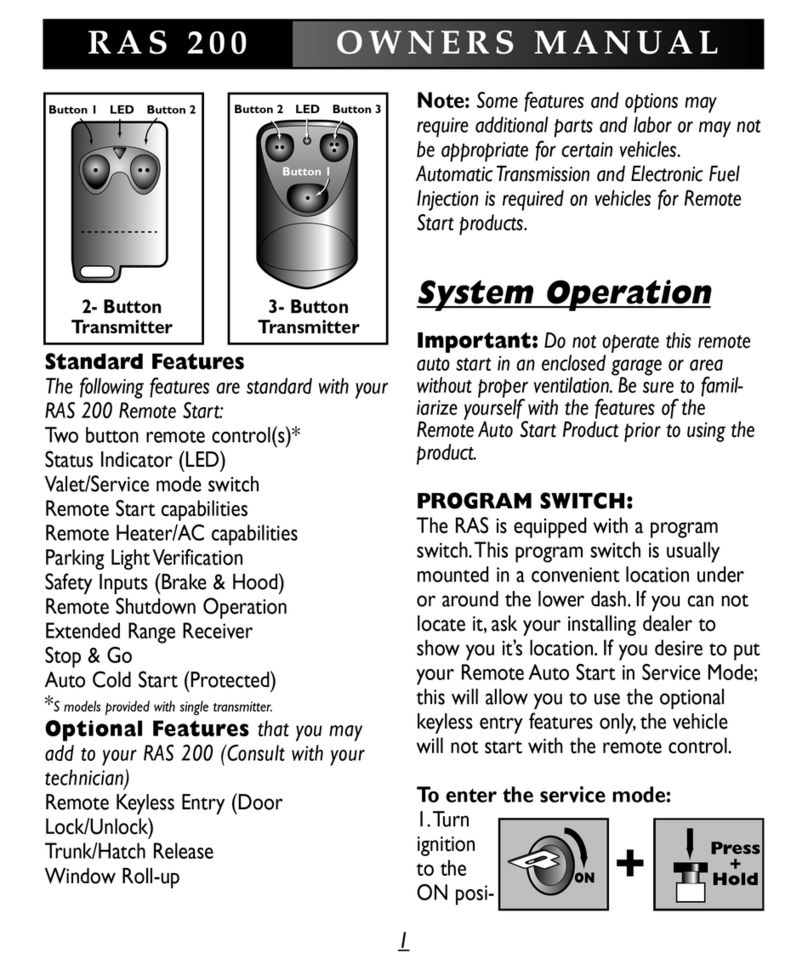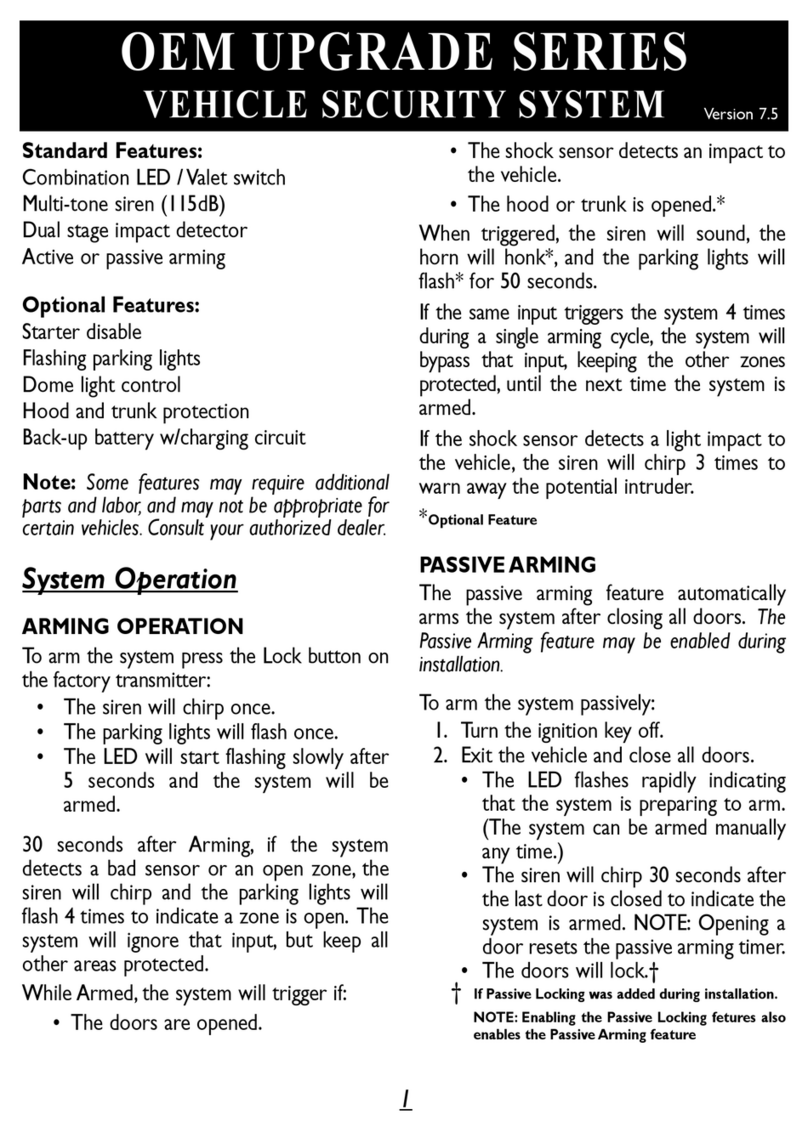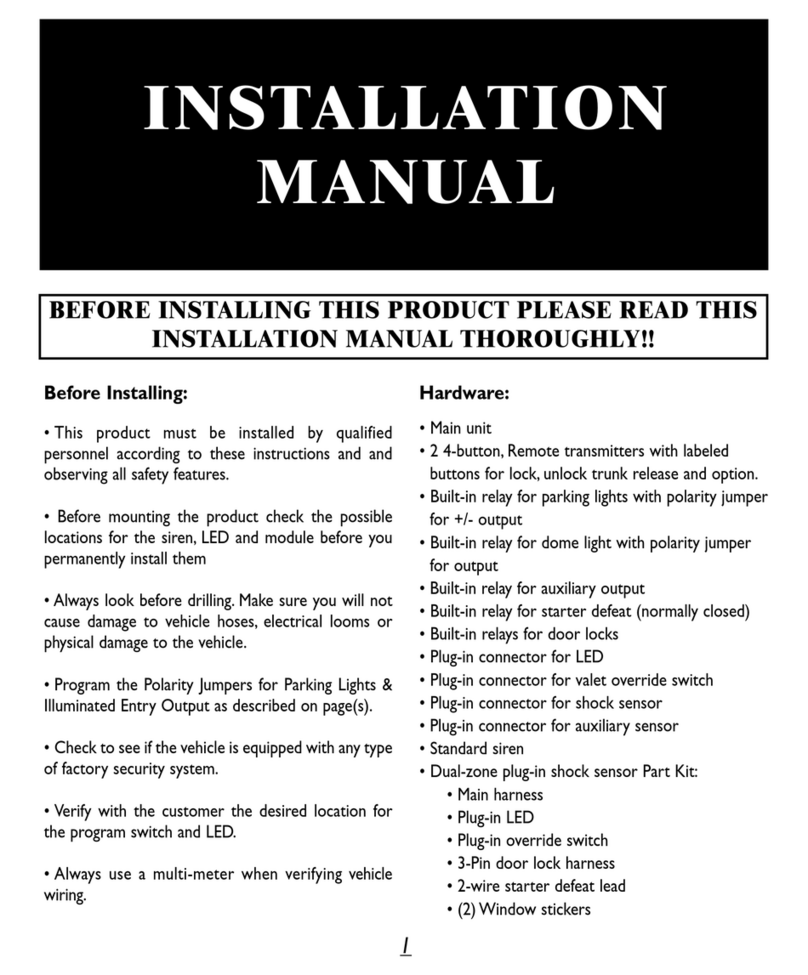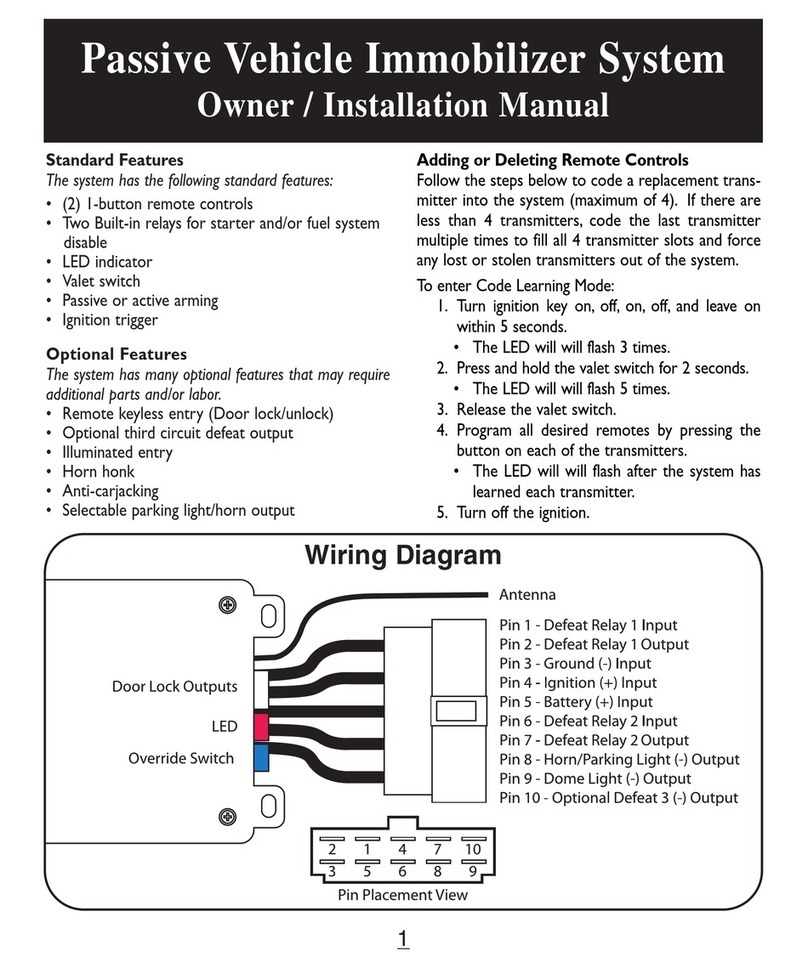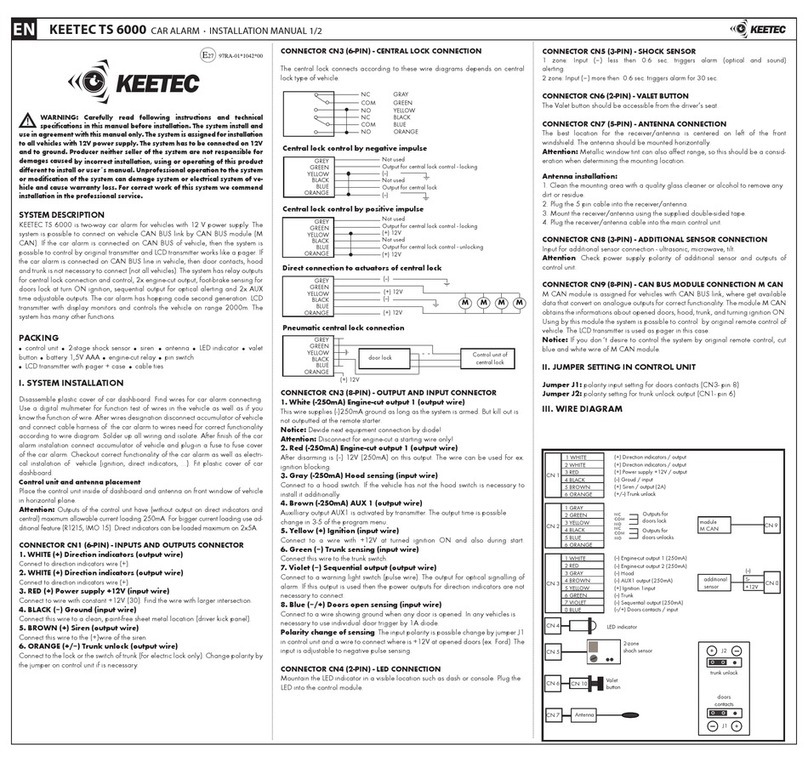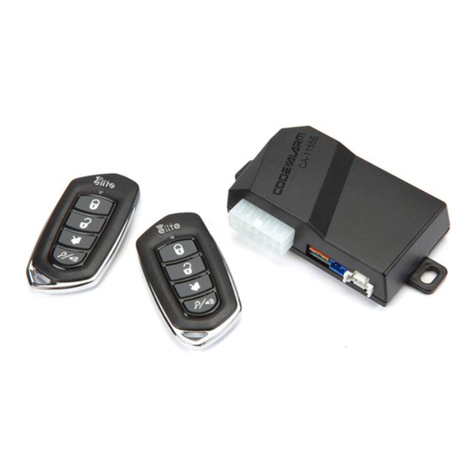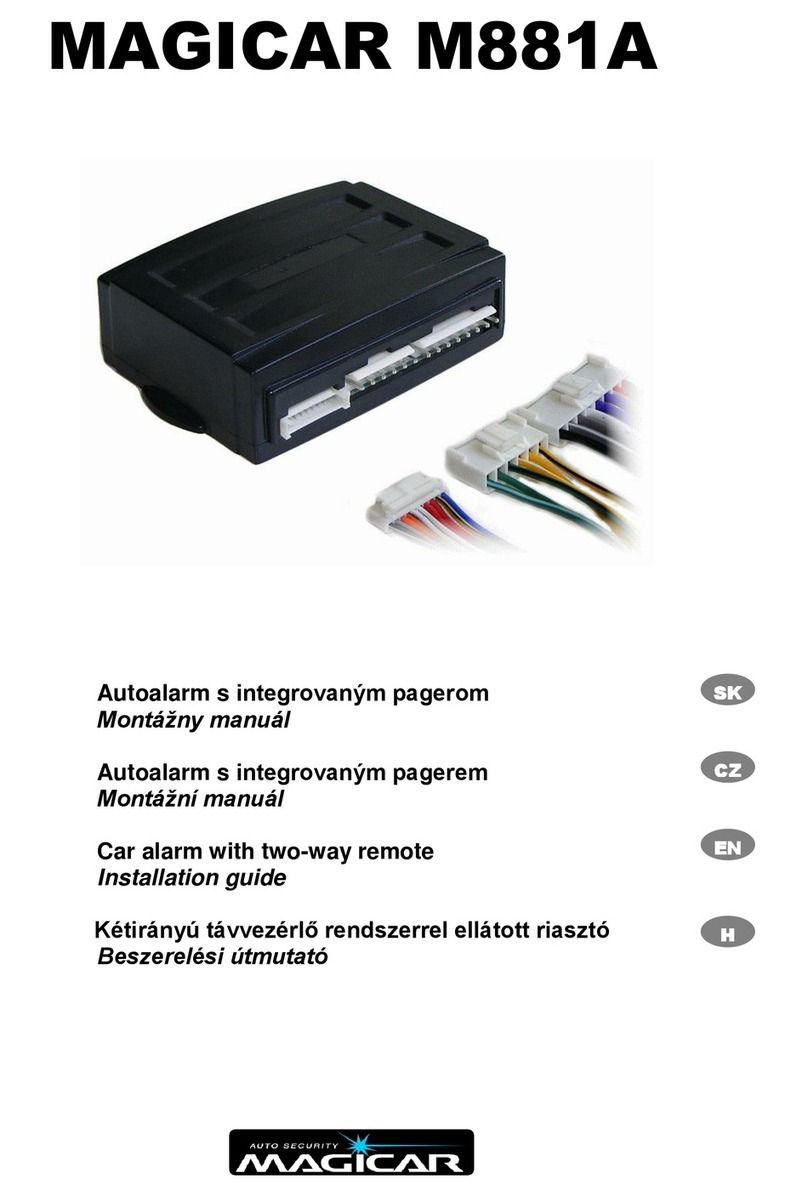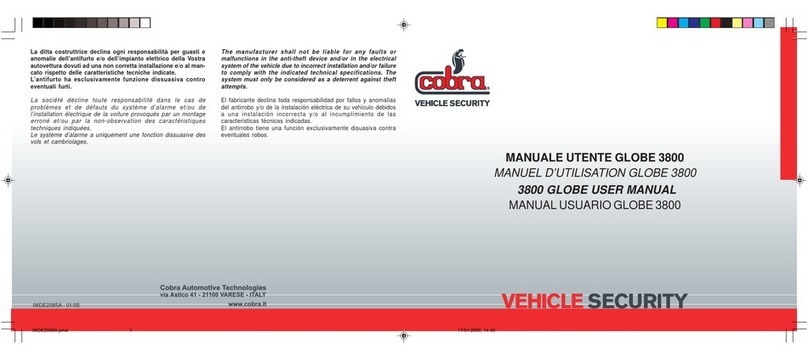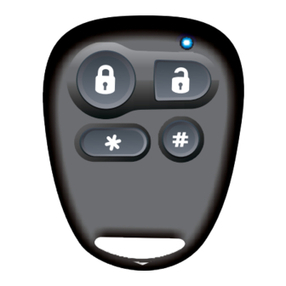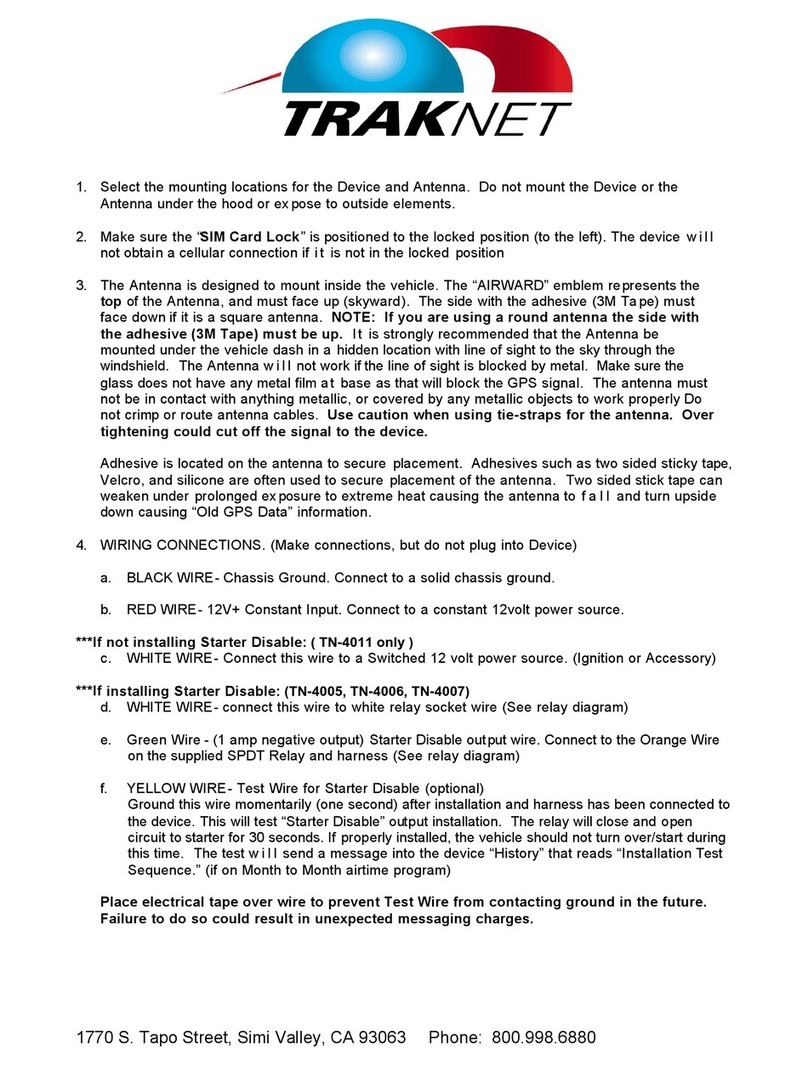Black Widow Security BW2900R2 User manual

1
Standard Features:
Two 4-Button Remote Transmitters
Status indicator (LED)
Valet / override switch
Multi-tone siren (120dB)
Dual stage impact detector
Remote panic
Remote chirp mute
Remote sensor bypass
Active or passive arming
Optional Features:
Starter disable
Flashing parking lights
Keyless entry
Remote trunk or hatch release
Illuminated entry
Hood and trunk protection
Remote auto start
Power window roll up
Back-up battery w/charging circuit
Glass break sensor
Note: Some features may require additional
parts and labor, and may not be appropriate for
certain vehicles. Consult your authorized dealer.
System Operation
ARMING OPERATION
To arm the system press transmitter button 1:
• The siren will chirp once.
• The parking lights will flash once.*
• The doors will lock.*
• The LED will turn solid for 10 seconds
then start flashing slowly. After 10
seconds the system is armed.
After Arming, if the system detects a bad
sensor or an open zone, the siren will chirp
and the parking lights will flash 4 times to
indicate a zone is open. The system will
ignore that input, but keep all other areas
protected.
While Armed, the system will trigger if:
• The doors are opened.
• The shock sensor detects an impact to
the vehicle.
• The hood or trunk is opened.
When triggered, the siren will sound, the
horn will honk*, and the parking lights will
flash* for 30 seconds.
If the same input triggers the system 3 times
during a single arming cycle, the system will
bypass that input, keeping the other zones
protected, until the next time the system is
armed.
If the shock sensor detects a light impact to
the vehicle, the siren will chirp and the
parking lights will flash 5 times to warn away
the potential intruder.
*Optional Feature
2R / 4-BUTTON SERIES
VEHICLE SECURITY SYSTEM
Button
2
Button
3
Button
1
Button
4

2
PASSIVE ARMING
The passive arming feature automatically
arms the system after closing all doors. The
Passive Arming feature requires the ignition
to have been on for at least 10 seconds prior
to exiting the vehicle. This enables the key to
be turned on then off quickly to avoid
passive arming in the event of refueling,
washing the vehicle, etc. The Passive Arming
feature may be enabled during installation.
To arm the system passively:
1. Turn the ignition key off (make sure
ignition was on for at least 10 seconds).
2. Exit the vehicle and close all doors.
• The LED flashes rapidly indicating
that the system is preparing to arm.
(The system can be armed any time
by pressing transmitter button 1.)
• If the optional countdown feature is
programmed, the siren will chirp
every 2 seconds until armed.
• The siren will chirp 30 seconds after
the last door is closed to indicate the
system is armed. NOTE: Opening a
door resets the passive arming timer.
• The doors will lock.†*
†If Passive Locking was enabled during installation.
DISARMING OPERATION
To disarm the system press transmitter
button 2.
• The siren will chirp twice.
• The parking lights will flash twice.*
• The doors will unlock.*
• The dome light will turn on for 30
seconds.*
TAMPER ALERT
If the alarm was triggered while away from
the vehicle, the siren will chirp 3 times and
the parking lights will flash 3 times on
disarming for tamper indication.
AUTO REARM
The Auto Rearm feature allows the system to
automatically re-arm and lock the doors* in
the event the system is disarmed and a door
is not opened within 30 seconds. This
programmable feature may be enabled during
installation.
SILENT ARMING/DISARMING
Press transmitter button 3 to silently Arm or
Disarm the system for one-time operation.
The system can also be programmed for full-
time silent operation during installation.
IGNITION LOCK*
The ignition locking feature automatically
locks the doors 5 seconds after the ignition
key is turned on, and automatically unlocks
when the ignition key is turned off. To avoid
locking keys in the vehicle, the ignition
locking feature will be cancelled if a door is
open when the ignition is turned on. This
feature may be disabled during installation.
REMOTE PANIC
In the event of an emergency (PANIC)
situation, the system’s siren can be triggered
for 30 seconds to attract attention. To activate
the Panic Feature, press transmitter button 1
for 3 seconds:
• The siren will sound.
• The parking lights will flash*.
Press button 1 to exit panic mode and rearm
the system. Press button 2 to exit panic
mode and disarm system.The Panic Feature
will not operate when the ignition is on.
*Optional feature

3
EMERGENCY OVERRIDE
If the transmitter becomes lost or fails to
operate, the system can be disarmed by
using the emergency override feature.
To override the system:
1. Enter the vehicle.
• The alarm will trigger.
2. Turn on the ignition key.
3. Press the Valet switch for 3 seconds.
• The siren will stop sounding.
• The starter defeat will be bypassed.
• The system will enter valet mode.
VALET MODE
When the system is placed into the Valet
Mode the security system will be disabled.
However, the optional keyless entry and
trunk release features will still function if
installed. The valet feature may be accessed
using the valet switch or using the remote
transmitter.
To enter or exit valet mode using the switch:
1. Be sure the system is disarmed.
2. Turn the ignition key on.
3. Press and hold the valet switch for 3
seconds.
• The siren will chirp once to enter
valet or twice for exit.
• The LED will turn on solid indicating
the system is in valet mode, or turn
off indicating valet mode exit.
To enter or exit valet mode using the
remote:
1. Be sure the ignition key is off.
2. Press transmitter button 2 then button
1 and hold for 3 seconds.
• The siren will chirp once to enter
valet or twice for exit.
• The LED will turn on solid indicating
the system is in Valet Mode, or turn
off indicating Valet Mode exit.
OPTIONAL TRUNK RELEASE
Press button 3 for approximately 2 seconds
to open the trunk.
OPTIONAL TRUNK DISARM
The trunk disarm feature allows the alarm to
disarm automatically whenever transmitter
button 3 is used to activate the optional
trunk release. This eliminates having to first
disarm the alarm before activating the trunk
release. This feature must be programmed
during installation.
REMOTE SENSOR BYPASS
To arm the system and bypass the shock
sensor, press button 1 to arm, then within 2
seconds press button 4. The siren will chirp
once and sensors will be ignored until the
system is disarmed and rearmed.
STATUS INDICATOR (LED)
FUNCTION
S
On Solid = Valet Mode
On Solid and not in valet = Open Zone
Slow Flash = System Armed
Rapid Flash when disarmed = Passive
Arming
Rapid Flash when armed = Tamper Alert
PARKING LIGHT INDICATIONS
1 Flash = System Armed
2 Flashes = System Disarmed
3 Flashes = Tamper Alert
4 Flashes = Open Zone Indication (after
arming)
5 Flashes = Shock Sensor Warn-away

4
Before you begin the installation
• Read the INSTRUCTIONS!
• Always use a multi-meter when verifying
vehicle wiring.
• Before mounting the product, verify with
the customer the desired location for the
valet switch and LED.
• Protect the vehicle by using fender covers.
• Always look before drilling. Make sure you
will not cause damage to vehicle hoses,
electrical looms or physical damage to
vehicle.
• Set the parking light polarity jumper inside
the main unit.
Mounting The System Module
Mount the system module under the dash
where it will be difficult for a potential thief
to locate the module, and away from moving
parts such as brake pedals, etc. Route the
antenna wire away from wire looms,
computer modules and metallic objects for
better range.
Mounting The Siren
Mount the siren in a suitable place under
the hood, away from hot and moving engine
parts such as manifolds, fan belts, etc. Make
sure the siren cannot be accessed from
underneath the vehicle or through the grill.
Face the siren down so that water cannot
accumulate inside the siren bell. Protect
wires running through the firewall using
either tape or split loom tubing. If a new
hole is needed, protect the wire from
chaffing by installing a proper size grommet.
Mounting The Shock Sensor
Secure the shock sensor to the steering
column, thick wire harness or a dash brace,
using a wire tie. Make sure that the
adjustment screw is accessible for later
testing and adjustment.
12-Pin Main Harness:
• RED WIRE - +12V Battery input. Connect
the red fused wire on the main harness to a
constant +12V source. This source wire
should be at least 15 amp supply.
• GREEN WIRE - Negative door trigger (-).
Connect to the door switch circuit wire that
shows ground when the door is open.
• BLACK WIRE - Ground input (-). Connect
to a solid chassis ground that is clean and
free of paint or dirt.
• VIOLET WIRE - Positive door trigger (+).
Connect to the door switch circuit wire that
shows +12V when the door is open. This
type of door circuit is usually found on Ford
vehicles.
• YELLOW WIRE - +12V Ignition input.
Connect to a main ignition wire at the
ignition switch harness. This wire shows
+12V when the ignition is on and while
cranking. The voltage must not drop when
the car is starting.
• BLUE WIRE - Trunk/Hood trigger (-).
Connect the Blue wire to the trunk and/or
optional hood pin switches. The switch must
provide a ground output when switch is
opened.
• BROWNWIRE - Siren wire output (+) 3A.
Connect to the siren’s red wire. Connect
the siren’s black wire to ground.
Installation Instructions

5
• BROWN/WHITE WIRE - Horn output (-)
500mA. Connect to an optional relay to
activate the vehicle’s horn when the alarm is
triggered.
• BLACK/WHITE WIRE - Dome Light
output (-) 500mA. Connect to an optional
relay to activate the vehicle’s dome light.
• ORANGE WIRE - Armed Output (-)
500mA. The ORANGE wire provides a
ground when the unit is armed to activate a
circuit disable relay or other device (i.e.
window control module, etc.).
• GRAY WIRE - Auxiliary output (-) 500mA.
Connect to a relay for an optional feature
such as trunk release, etc.
• WHITE WIRE - Parking Light output (+/-)
10A relay. Connect to the vehicle’s parking
light wire. If the vehicle’s parking light circuit
exceeds 10 amps a relay is required. For
vehicle’s with independent left and right
parking light circuits, the parking light wires
must be connected using diodes to keep the
circuits separate. Make sure to set the
proper polarity for the internal relay jumper
before connecting the main harness. NOTE:
Do not connect the WHITE wire to the
vehicle’s headlight circuit.
Starter Defeat Connectors
Using a volt/ohm meter locate the starter
wire (normally a heavier gauge wire) at the
ignition switch.This wire will show +12V only
during cranking. When this wire is cut the
vehicle will be unable to start. Cut the
BROWN starter disable wire (with the two
female connectors), and connect one side to
the vehicle’s starter wire coming from the
key switch. Connect the other BROWN wire
to the wire going to the starter. Plug the
female connectors on the BROWN wires to
the .250 male spade lugs on the module.With
the BROWN wires connected to the
module, the vehicle should be able to start.
Plug in Connectors
3-Pin White Door Lock Connector: Plug-in
connector port for door lock harness or
optional door lock relay module.
• BLUE WIRE - unlock output (-) 500mA.
• RED WIRE - +12V output (+) 300mA for
relay modules, or inverters. Do NOTuse as a
power source for door lock relays.
• GREEN WIRE - lock output (-) 500mA.
2-Pin Red Connector: Plug-in connector
port for LED. Mount LED in an area where it
may be easily seen from either side of the
vehicle.
2-Pin Blue Connector: Plug-in connector
port for valet switch. Mount switch in an area
that is easily accessible from the driver’s seat.
4-Pin White Connector: Plug-in connector
port for dual stage shock sensor.
Entering Programming
To enter System Programming:
1. Turn on ignition.
2. Within 5 seconds, press valet switch 5
times.
• The siren will emit a long chirp, to
indicate entering program mode.
3. Press the valet switch the number times
equal to the desired feature.
• The siren will chirp each time the valet
switch is pressed. A long chirp is equal
to 5 presses. (Example: step 7 = 1 long
chirp and 2 short chirps.)
4. Within 5 seconds, press the transmitter
button corresponding to the desired
operating mode for that feature.
• The siren will chirp to indicate the
setting.
One chirp = Button 1
Two chirps = Button 2
Three chirps = Button 3
5. Turn off ignition to save changes.

6
Complete Default Reset
This procedure will set all Programmable
Features to factory default settings.
1. Enter System Programming.
2. Press Transmitter Button 3.
• The siren will chirp 6 times.
• All Programming options are now set
to factory default settings.
2. Turn ignition off.
Programmable Features
1. Arming Mode. Select between manual
arming (Active), automatic arming (Passive),
and automatic arming with chirps that
countdown every 2 seconds until armed.
2. Parking Light Operation. Selects whether
the parking lights flash twice or remain on
for 30 seconds after disarming the system.
3. Auto Rearm. Automatically rearms the
system in case of accidental disarming. The
system must be armed for at least 10
seconds before disarming, and the
hood/trunk must not be opened or auto
rearm is bypassed. If button 3 is selected, the
doors will lock on auto rearm.
4. Arming Chirps. Select Normal or Silent
Arming.
5. Trunk Disarm Feature. When selected,
activating the Auxiliary function to open the
trunk will automatically disarm the system.
6. Ignition Locking. Automatically locks and
unlocks the doors with the ignition. The
system will not lock the doors if any door is
open when the ignition is turned on.
7. Door Lock Pulse. Selects between a 1-
second and a 3-second output for vehicles
equipped with vacuum door locking systems.
8. Passive Locking. Selects whether or not
the system will automatically lock the doors
with Auto Rearm and Passive Arming.
9. Door Unlock Pulse - Single or Double.
Selects between a single pulse or a double
pulse door unlock output.
10. Open Door Report. Siren will chirp 4
times if a door remains open 10 seconds
after arming. If vehicle has delayed dome
light, program for 60 seconds (the sensor
and trunk still report after 10 seconds).
11. Siren / Horn Chirps.When set for Horn
Chirps the horn will honk when the alarm is
armed, disarmed, and triggered, allowing the
siren to NOT be installed. Button 3 adds
horn chirps with the warn away feature as
well.
Programmable Features
Step Function Button 1 (default) Button 2 Button 3
1. Arming Mode Active Passive Passive w/Countdown
2. Parking Light Operation Flash twice 30 seconds
3. Auto Rearm Off Auto Rearm Auto Rearm w/ Lock
4. Arming Chirps Normal Silent
5. Trunk Disarm Off On
6. Ignition Locking On Off
7. Door Lock Pulse 1 second 3 seconds
8. Passive Locking Off On
9. Door Unlock Pulse Single Double
10. Open Door Report 10 seconds 60 seconds
11. Siren / Horn Chirps Siren only Horn Chirps Horn Chirps w/Warn

7
Test System and Adjust Shock Sensor
Arm and disarm system, checking that the
siren chirps and parking lights are functioning
normally. Make sure that the programmed
features are performing correctly, ie.: ignition
locks, passive arming, passive locks, etc.
Test the doors and hood/trunk inputs (make
sure all doors trigger the system, not just the
driver’s door).
Adjust the shock sensor.
Arm the system and try starting the vehicle,
it should not start.
Arm the system and disarm it using the
emergency override feature.
If programmed to passively arm make sure
that the system arms properly.
Check the range of the remote transmitters.
Tie up wire harness, and replace any under
dash panels.
Make sure the customer has physical
knowledge of the location of the
valet/override switch.
Adding Transmitters
To add a new transmitter to the system have
the desired transmitters ready and follow
the Code Learning sequence.
To enter Code Learning Mode:
1. Turn the ignition on, off, on, off and leave
on.
• The siren will chirp once.
2. Press and hold the Valet switch for 5
seconds.
• The siren will chirp 3 times.
3. Press the Lock Button on the transmitter.
• The siren will chirp once.
4. Repeat step 3 for each additional
transmitter, up to four total transmitters.
5. Turn off the ignition.
• The siren will chirp 3 times.
NOTE: If a transmitter is lost of stolen, make
sure to code all 3 transmitter memory
locations. (Example: If only one transmitter is
used, repeat step 3 two more times to remove
any previously programmed transmitters.)

8
Caracteristicas Estandard
2 transmisores de 4 botones
Indicador Luminoso (LED)
Interruptor de valet/cancelación
Sirena multitonos (120dB)
Sensor de impacto doble
Pánico remoto
Reducción de volumen del chirrido
Desactivación del sensor
Armado activo/pasivo
Características Opcionales
Interruptor de encendido
Abrir y cerrar de seguros electricos
Entrada illuminada
Luces exteriores centellantes
Apertura de cajuela
Protecion de maleta/capot
Encendido del motor
Activación de ventanas
Batería de Emergencia
Sensor de crystales
Sensor de microondas
Nota: Estas funciones opcionales pudieran
requerir partes y mano de obra adicional o no
sean apropiados para todos los vehiculos.
Sistema de Operación
OPERACION DE ARMADO
Armado activo– Para activar la alarma,
oprima el botón 1 del control remoto.
Escuchará un chirrido de la sirena, las luces
de exteriores centellean una vez y el LED
(indicador luminoso) se prenderá sólido,
palpitando lentamente despues de 10
segundos. El sistema está armado, ahora si
alguna puerta, la cajuela, maletero o sensores
se encuentra abierta, la alarma dará 4
chirridos.
Aislamiento de entrada de sensor o
puerta defectuosa:
Si la entrada de una puerta, sensor o de
cajuela etc., se mantiene activa por más de 3
ciclos (de 30 segundos cada uno) se aislará e
ignorará, y las demas entradas seguiran
protegidas. La entrada volverá a su estado
normal al armar y desarmar la alarma.
Armado pasívo– Si el sistema fué
programado para armarse pasivamente,
simplemente apague el encendido y salga del
vehículo, asegurese que el encendido estuvo
prendido más de 10 segundos. El sistema se
activará 30 segundos despues del cierre de la
última puerta. El LED centellará rápidamente
para indicar que está en estado de
prearmado.
Para evitar el Armado Pasívo, prenda y
apague la llave ANTES de 10 segundos, ésta
función es útil cuando necesita salir del carro
para poner gasolína o para lavarlo, etc.
Siempre podrá activar la alarma oprimiendo
el botón 1 del transmisor en cualquier
momento. Si el sistema fue programado
SERIE 2R / 4-BOTONES
SISTEMAS DE SEGURIDAD PARA VEHICULOS
Botón
2
Botón
3
Botón
1
Botón
4

9
pasivamente con conteo de chirridos, la
alarma dará un chirrido cada 2 segundos
hasta armarse.
OPERACION DE DESARMADO:
Para desactivar la alarma oprima el botón 2
del transmisor. Habra 2 chirridos de la
sirena, las luces centellean dos veces. El LED
dejara de centellar. El sistema esta
desarmado. Si tiene entrada illuminada
(prenden las luces de cabina
automáticamente) estas quedan prendidas
por 30 segundos o hasta encender el
vehículo o rearmar el sistema.
MEMORIA DE INTENTO DE
VIOLACION:
En el evento de que su sistema haya sido
activado escuchará 3 chirridos y las luces
centellarán 3 veces al desarmar el sistema
con el transmisor. Esto indica que
posiblemente hubo intento de entrada a su
vehículo.
REDUCCION DEL CHIRRIDO DE LA
SIRENA
Si quiere reducir el volumen del chirrido de
la alarma, oprima el botón 3 momentane-
amente para armar ó desarmar. Se
escucharan los chirridos cerca del vehículo.
ELIMINACION DEL CHIRRIDO DE
LA SIRENA:
Si quiere eliminar completamente el chirrido
de armado/desarmado: Esta funcion puede
ser programada por su consecionario
autorizado.
CIERRE DE PUERTAS CON
IGNICIÓN
Con las puertas cerradas, ésta función
permite que se cierren los seguros de
puertas automáticamente después de 5
segundos al poner la llave en posición de
encendido. Al sacar la llave nuevamente del
encendido los seguros de puertas se abriran.
Esta función puede ser programada por su
concesionario.
PANICO REMOTO
En caso de emergencia personal, ud. puede
activar la sirena oprimiendo el botón 1ó 2
por 3 segundos, sonará la sirena y las luces
centellarán y el pánico remoto durará 30
segundos ó hasta que ud. oprima el botón 1
ó 2 nuevamente. El pánico remoto no funciona
con el encendido prendido.
CANCELACION DE EMERGENCIA
Si se perdiera el transmisor ó se
descompone.Abra la puerta, sonará la sirena,
de vuelta a la llave en posición de encendido.
Oprima el boton de valet/cancelación por 3
segundos, el sistema se cancelará y permitirá
que se encienda el vehículo. El sistema
automáticamente se pondrá en modo valet y
no se armará el sistema. (vea modo valet
para cancelar esta función).
MODO VALET
El modo valet evitará que se arme su sistema
pasivamente (cuando este programado para
hacerlo) mientras lavan ó arrreglan su
vehículo, etc. Para activar el modo valet,
desarme el sistema, de vuelta a la llave a la
posición de encendido y oprima y detenga el
boton de valet/cancelación por 3 segundos,
la sirena dara un chirrido y el LED se
prendera sólido. Su vehículo estará en modo
valet. Si su sistema tiene activación de
puertas via el transmisor, ud. podrá activarlos
aun en modo valet. Para desactivar el modo
valet– Repita la secuencia anterior, se
apagará el LED y se escuchará 2 chirridos.

10
DESACTIVACION TEMPORAL DEL
SENSOR
Si desea que el sistema ignore el sensor o
sensores pero quiere seguir monitoreando
las puertas o cajuela, oprima el botón 1,
escuchará un chirrido normal. Antes de 5
segundos oprima los botones 4, escuchará
un chirrido confirmando que no se
monitorearan los sensores. Al desarmar el
sistema de alarma volverá a su estado
normal de monitoreo.
DESACTIVACIÓN ACCIDENTAL
Si se ha desarmado accidentalmente la
alarma con el transmisor: Para evitar que su
vehículo quede sin protección al desarmarse
accidentalmente la alarma. (si no se ha
abierto las puertas). Esta función puede ser
programada por su concesionario para
rearmarse automáticamente despues de 30
segundos.
REMPLAZO DE TRANSMISOR
Su consecionario autorizado puede
programar más transmisores y borrar los
codigos de aquellos transmisores perdidos o
robados para que no puedan operar su
vehículo.
MODO DE SERVICIO
Si necesita llevar su vehículo a un taller para
hacerle servicio ó un lavado de autos pero
no quiere dejar su transmisor, ud. puede
poner su sistema en modo de servicio.
Oprima el botón 2 y despues el botón 1 por
3 segundos, la sirena sonará 1 vez y el
indicador luminoso se prenderá solida.
Para desactivar el Modo de Servicio
simplemente oprima el botón 2 y despues el
botón 1 por 3 segundos, la sirena sonará 2
veces. regresando a su estado normal.
ABRIDOR DE CAJUELA
AUTOMATICO
Presione el botón 3 por dos segundos, para
abrir la cajuela.
DESARME LA ALARMA AL ABRIR
CAJUELA
Su consecionario autorizado puede
programar esta funcion.
INDICADOR LED
Apagado = Sistema está apagado en modo
activo
Centelleo lento = Sistema armado
Centelleo rápido = Estado pasívo de
prearmado
Sólido = En valet o modo de servicio
Sólido = (Despues de prearmado pasivo o
armado activo) 10 segundos finales del
prearmado
Sólido = (cuando desarmado y no en modo
valet o de servicio) - Algun interruptor
abierto.
INDICADORES DEL CHIRRIDO
1 chirrido = sistema armado
2 chirridos = sistema desarmado
3 chirridos = al desarmar el sistema, posible
intento de entrada a su vehículo.
4 chirridos = sistema armado pero hay un
interruptor o sensor abierto
5 chirridos rápidos = El modo de advertencia
del sensor de impacto.
6 chirrdos = Modo de fábrica reestablecido

11
Antes de installar:
• Lea todas las INSTRUCCIONES!
• Siempre use un voltimetro digital o
analogico.
• Antes de instalar permanentemente,
determine done sera montado cada
componente (sirena, modulo, LED, etc.).
• Proteja el guarda fangos durante la
instalacion.
• Siempre vefique que no se danaran los
cables, mangueras o el vehiculo en general
cuando use un taladro.
Instale el módulo receptor en un lugar
seco y seguro donde no pueda ser alcanzado
fácilimente ó dañado y donde los alambres
puedan ser fácilimente instalados. Instale el
módulo lo más lejos de objetos de metal
como sea posible. Esto incrementa el alcance
de su transmisor.
Instale la sirena: Encuentre un lugar seguro
debajo del cofre, alejado de piezas calientes
o movibles del motor, como mangueras,
bloque, turbo cargadores, etc. Asegure con
tornillos la sirena a lugar sólido.Asegure que
no se pueda tener acceso a la sirena y sus
alambres por debajo del vehículo o por
entre la parrilla.Apunte la sirena hacia abajo
para evitar acumulación de humedad en la
bocina. Cuando pase alambres hacia dentro
del vehículo, use cinta de aislar o entubado
de plástico para protegerlos, procurando
usar los hoyos existentes (con protecciones
de hule). Si se hace necesario otro orificio en
la pared protegalo con una bota de hule
apropiada.
Instale el sensor de impacto
Asegure con amarres de plástico el sensor
de impacto a la columna del volante, un
grupo de alambres resistentes, o un refuerzo
del tablero. Conecte el contacto
correspond-iente al sensor y el otro lado al
contacto blanco de 4 conectores del
módulo.Asegure que el tornillo de ajuste del
sensor este accesible para calibrar
posteriormente. No monte el sensor en el
cofre del vehículo!
Instale el indicador luminoso (LED)
Encuentre un lugar apropiado para instalar el
LED (donde pueda ser visto fácilmente
desde afuera del vehículo). Haga un hoyo
asegurando que tenga profundidad suficiente
para que asiente bien. Con cuidado corra los
alambres del LED por el orificio y
conéctense al contacto rojo del módulo.
Instale el interruptor de Valet y
cancelación
Instale el interruptor de valet en un lugar
oculto pero de fácil acceso para el
conductor en caso de emergencia. Corra los
dos alambres del interruptor con su
contacto azul al contacto azul corespond-
iente del módulo.
INSTRUCCIONES DE INSTALACION
DE ALAMBRES
• ALAMBRE ROJO - Conecte la entrada de
+12V. Alambre rojo (con fusible) en el
contacto principal. Conecte el alambre rojo
a una fuente constante de +12V y que
suministra 20 amps.
Favor de leer estas instrucciones antes de intentar instalar la alarma.
Manual De Instalacion

12
• ALAMBRE VERDE - Conecte la entrada
negativa de puertas. Conecte el alambre
verde al alambre que tenga tierra cuando se
abran todas las puertas. Verifíquelo con un
voltímetro. Asegúrese que este alambre
común tenga tierra cuando se abran todas
las puertas separadamente.
• ALAMBRE NEGRO - Conecte la entrada a
tierra. Localice un buen contacto a tierra y
conecte al alambre` negro del contacto
principal. Verifique la tierra con un
voltímetro.
• ALAMBRE VIOLETA - Conecte la entrada
positiva de puertas. Conecte el alambre
violeta del modulo al alambre que produce
+12V cuando todas las puertas son abiertas.
Verifiquelo con un voltímetro.Asegúrese que
este alambre comun tenga +12V cuando se
abran todas las puertas separadamente.
• ALAMBRE AMARILLO - Conecte la
entrada para +12V del encendido. Conecte
el alambre amarillo del contacto principal al
alambre principal de la marcha. Este también
puede localizarse en el contacto principal del
interruptor del encendido. Su voltímetro
debe leer +12V cuando la llave esta en
encendido. Asegure que esté suministrando
+12V aun durante el proceso de encendido;
es importante que no disminuya el voltaje
cuando se esta encendiendo el vehículo.
Algunos vehículos tienen alambres que
permanecen o disminuyen lentamente a 0
voltios. El voltaje debe bajar inmedia-
tamente a 0 voltios cuando se apague el
encendido. Si el alambre amarillo tuviere
voltaje cuando se apague el encendido,
impedirá que se arme la alarma vía el
transmisor.
• ALAMBRE AZUL - Conecte la entrada del
interruptor de maletera/capot. Conecte el
alambre azul al alambre(s) del interruptor de
la maletera, capot o ambos. Debe producirse
corriente a tierra cuando se abran.
• ALAMBRE CAFE - Conecte la salida de la
sirena. Conecte el alambre café al alambre
rojo de la sirena.
• ALAMBRE CAFE/BLANCO - Conecte la
salida para Claxon (vea del diagramás pagina
15).
• ALAMBRE NEGRO/BLANCO - Conecte
la salida para iluminación de cabina (vea del
diagramás pagina 15).
• ALAMBRE NARANJA - Connecte el
alambre Naranja de cancelación del
encendido. Usando un medidor de voltaje
localice el alambre de apagado
(generalmente un alambre más grueso) del
interruptor de la marcha. El medidor indicará
+12V en el momento de encendido. Cuando
localice el alambre, córtelo no podrá
encender el vehículo. Conecte el alambre
rojo del relevo a el alambre de la llave,
conecte el alambre blanco del relevo al
motor de arranque. Por último conecte el
alambre naranja del relevo al alambre naranja
de la alarma.
• ALAMBRE GRIS - Conecte la salida del
2do. canal. La salida es de 250ma y activa un
relevo para operar un motor de
desenganche de cajuela (vea del diagramás
pagina 15).
NOTA: Esta salida trabaja con el encendido
prendido o apagado. Oprimiendo el boton 2
por tres segundos se suministra señal al
alambre violeta mientras se mantenga
oprimido.
• ALAMBRE BLANCO - Conecte la salida
para luces intermitentes. Usando un
voltímetro, localice el alambre (normalmente
en el interruptor de las luces) que tenga +12V
cuando se prenden las luces.Algunos vehículos
europeos necesitarán un relevo adicional si
las luces tienen alambres separados para
encender las luces izquierda y derecha. Esta

13
salida con relevo tiene un máximo de 15
amps. No se conecte directamente a las luces
de manejo! (vea del diagramás pagina 16).
ENCHUFES DE SEGUROS
ELÉCTRICOS
Conecte el alambre Verde del activador de
cierre de puertas: El alambre Verde provee
500mA. negativos pulsantes para cerrar
seguros de puertas y esta salida tambien esta
diseñada para activar un relevo (vea del
diagramás pagina 15).
Conecte el alambre Azul del activador de
abrir de puertas: El alambre Azul provee
500mA Negativos pulsantes para abrir
seguros de puertas y también la salida está
diseñada para activar un relevo (vea del
diagramás pagina 15).
FUNCIONES PROGRAMABLES
La alarma ha sido actualizada con funciones
programables adicionales.
Se pueden programar las siguientes
funciones:
1. Modo de Armado. Seleccione entre
armado manual (áctivo), automático
(pasivo) y automático con 2 chirridos cada 2
segundos hasta armarse el sistema.
2. Operación de Luces Centellantes. Se
selecciona si las luces centellean 2 veces o
permanecen prendidas por 30 segundos
despues de desarmarse el sistema.
3. Desarmado Accidental. Rearma el
sistema en caso de desarmarse
accidentalmente. El sistema tiene que haber
estado armado por lo menos 10 segundos, la
cajuela o cofre deben haber permanecido
cerrados y el modo pasivo deshabilitado
para desarmarse.
4. Eliminación de Chirrido. Selecciona si
desea armado con o sin chirrido.
5. Desarme del 2o. Canal. Cuando esta
función es seleccionada, al abrir una cajuela o
cofre con el transmisor, se desarma el
sistema automaticamente.
6. Cierre Seguros con Ignición. Cierra o
abre los seguros de puertas con llave en
ignición. Esta función se cancelará si hay una
puerta abierta cuando se de vuelta a la llave.
7. Tiempo de Pulso de Cierre de Seguros.
Escoga el pulso de activación de seguros de
puertas entre 1 o 3 segundos. Para vehiculos
con sistema de cerraduras al vacio.
8. Cierre Seguros/Modo Pasivo . Seleccione
si han de cerrarse los seguros de puertas o
no cuando en modo pasivo o activo.
Funciones Programables De La Alarma
Opción# Función Botón 1 (de fábrica) Botón 2 Botón 3
1. Modo Activo/Pasívo Activo Pasívo Pasívo con Chirrido
2. Luces Centellantes 2 centellos 30 segundos –
3. Desarmado Accidental Apagado Prendido Pasivo/cierra seguros
4. Eliminación de Chirrido Prendido Apagado –
5. Desarme con 2do Canal Apagado Prendido –
6. Cierre Seguros con Ignición Prendido Apagado –
7. Tiempo de Pulso/Seguros 1 segundo 3 Segundos –
8. Cierre Seguros/Modo Pasívo Apagado Prendido –
9. Pulso de Seguros Eléctricos 1 Pulso 2 Pulsos –
10. Reporte de Zona Abierta 10 segundos 60 segundos –
11. Chirrido de Sirena o Claxon Sirena Claxon Claxon con advertencia

14
9. Tiempo de Pulso/Abrir Seguros. Escoge
entre pulso sencillo o doble para abrir
seguros de puertas.
10. Reporte de Zona Abierta. La sirena dará
4 chirridos si permanece abierta una puerta
10 segundos despues de un intento de
armado. Si el vehiculo tiene programado la
luz de cabina prendida al cerrar las puertas,
escoga 60 segundos (el sensor o cajuela
reportan despues de 10 segundos).
11. Chirridos de Sirena ó Claxon. Cuando se
escoge la función de Claxon, ésta sonara
cuando se active la alarma y se desactiva la
sirena. Con el botón 3 se agrega al claxon la
función de advertencia.
Como Programar Las Funciones
1. De vuelta a la llave a la posición de
encendido.
2. Oprima el botón de cancelación 5 veces;
la sirena dará un chirrido largo.
3. Seleccione la función deseada (Funciones
programables del sistema de alarma) y
oprima el botón de cancelacion el numero
de veces indicado para esa función; habrá un
chirrido cada vez que se oprima el botón.
4. Oprima el botón corresponiente de su
transmisor para la función deseada y
confirmándose con 1 o 2 chirridos.
Revisar Todas Las Funciones
1. Ajuste el sensor de impacto
electrónico a la sensibilidad necesaria
antes de chequear el funcionamiento de
la alarma.
• De vuelta al tornillo de ajuste
completamente hacia la derecha.
• De vuelta lentamente hacia la
ízquierda golpeando fuertemente
varias partes del vehículo.
• El sensor esta ajustado cuando, de
acuerdo a la sensibilidad deseada, la
alarma es activada con un golpe
fuerte al vehículo.
2. Verifique que todas las funciones de la
alarma trabajen correctamente.
3. Termine la instalación de la alarma
asegurando los alambres en su lugar y
protegiéndolos con una cubierta de
plástico donde sea posible.
MODO DEAPRENDIZAJE DE CODIGO
Para que el sistema aprenda los códigos de
los transmisores:
1. Asegure que el sistema está desarmado
y fuera de modo valet,
2. Dentro de 5 segundos, de vuelta a la
llave a la posición de encendido 3 veces
dejándola en encendido la tercera vez
(Encendido, Apagado, Encendido,
Apagado, Encendido). Se excuchará un
chirrido de la sirena, el LED centellará
un vez.
3. Antes de 5 segundos oprima y detenga
el interruptor de valet/cancelación por
5 segundos, escuchará una seria de
chirridos y el LED se prendera sólida.
4. Suelte el interruptor, y dentro de 5
segundos oprima el botón 1 de los
transmisores que desee que operen el
sistema, escuchara un chirrido cada vez
que un transmisor aprenda el código. El
sistema aprende hasta 3 códigos.
NOTA: Una vez que entra en modo de
aprendizaje de código, el sistema eliminará
los códigos anteriores de todos los
transmisors. Si está programando dos
transmisores con el mismo código, la alarma
reconocerá ambos, pero dará un chirrido
solamente.

15
DOOR LOCK
RELAYS
RELEVO DE
SEGUROS
(-) LOCK - CIERRE
(-) UNLOCK - ABRIR
BLUE - AZUL
GREEN - VERDE
LOCK/UNLOCK
SWITCH
L
UL
SWITCH
ABRIR/CERRAR
(+) LOCK - CIERRE
(+) UNLOCK - ABRIR
LOCK/UNLOCK
SWITCH
L
UL
86
30
87
87a 85
86
30
87
87a 85
GREEN - VERDE
BLUE - AZUL
+12V
DOOR LOCK
RELAYS
RELEVO DE
SEGUROS
SWITCH
ABRIR/CERRAR
ACTIVADOR DE
F`BRICA
FACTORY DOOR
MOTOR
CUT
CORTE
CUT
CORTE
X
X
86
30
87
87a 85
LOCK/UNLOCK
SWITCH
L
UL
BLUE
AZUL
+12V
86
30
87
87a 85
GREEN
VERDE
SWITCH
ABRIR/CERRAR
NEGATIVE TRIGGER
CIRCUITO NEGATIVO
POSITIVE TRIGGER
CIRCUITO POSITIVO
ADDING ACTUATORS
ACTIVADOR DE PUERTAS
REVERSE POLARITY
POLARIDAD INVERSA
DOOR LOCK WIRING DIAGRAMS
DIAGRAMA DE SEGUROS DE PUERTAS
ACTIVADOR DE
PUERTAS
AFTER-MARKET
ACTUATORS
86
30
87
87a 85
86
30
87
87a 85
GREEN
VERDE
BLUE
AZUL
+12V
RELAY WIRING DIAGRAMS
DIAGRAMA DE RELEVOS
86
30
87
87a 85
+12V
TO WIRE IN VEHICLE
A ALLAMBRE EN VEHICULO
(-) OUTPUT
FROM ALARM
(-) SALIDA
PARA ALARMA
86
30
87
87a 85
(-) OUTPUT
FROM ALARM
(-) SALIDA
PARA ALARMA
+12V
TO WIRE IN VEHICLE
A ALLAMBRE EN VEHICULO
POSITIVE TRIGGER
CIRCUITO POSITIVO
NEGATIVE TRIGGER
CIRCUITO NEGATIVO
VACUUM PUMP
BOMBA DE VACIO
CUT
86
30
87
87a 85
LOCK/UNLOCK
SWITCH
SWITCH
ABRIR/CERRAR
L
UL
BLUE
AZUL
+12V
86
30
87
87a 85
GREEN
VERDE
VACUUM SYSTEM
SISTEMA DE VACIO

16
WHITE - BLANCO (+/-)
BROWN - CAFE (+)
ORANGE - NARANJA (-)
BLACK - NEGRO (-)
YELLOW - AMARILLO (+)
GREEN - VERDE (-)
VIOLET- VIOLETA (+)
GRAY - GRIS (-)
BLUE - AZUL (-)
BLACK/WHITE - NEGRO/BLANCO (-)
BROWN/WHITE - CAFE/BLANCO (-)
RED - ROJO (+)
HORN - CLAXON
SIREN - SIRENA
LIGHTS - LUCES
DOME LIGHT -
LUZ DE CABINA
DOOR - PUERTA (-)
DOOR - PUERTA (+)
IGNITION - IGNICION (+)
TO BATTERY -
A BATERIA (+)
TRUNK/HOOD -
MALETA/CAPOT (-)
GROUND -
TIERRA (-)
BLUE - AZUL (-)
GREEN - VERDE (-)
LED
VALET - INTERRUPTOR DE VALET
SHOCK SENSOR - SENSOR DE IMPACTO
+12V
TO STARTER -
PARA MARCHA
IGNITION -
IGNICION
CUT -
CORTE
X
AUXILIARY -
SALIDAAUXILIER
ARMED OUTPUT -
SALIDAARMADO
= RELAY - RELEVO
= GROUND - TIERRA
WIRING DIAGRAM -
DIAGRAMA DE INSTALACION
© 2007 64-29.00, 7/07 Rev. 2
PARKING LIGHT JUMPER -
JUMPER DE LUCES
jump
POSITIVE - POSITIVO
jump
NEGATIVE - NEGATIVO
Table of contents
Languages:
Other Black Widow Security Car Alarm manuals
Popular Car Alarm manuals by other brands

Directed Electronics
Directed Electronics Python 571XP installation guide

Directed Electronics
Directed Electronics VIPER 5701 owner's guide
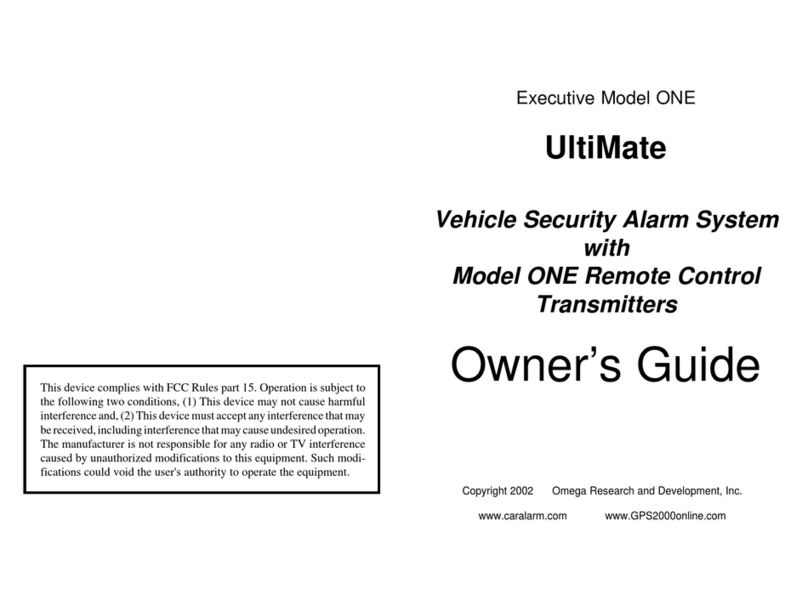
Omega Research & Development
Omega Research & Development UltiMate owner's guide
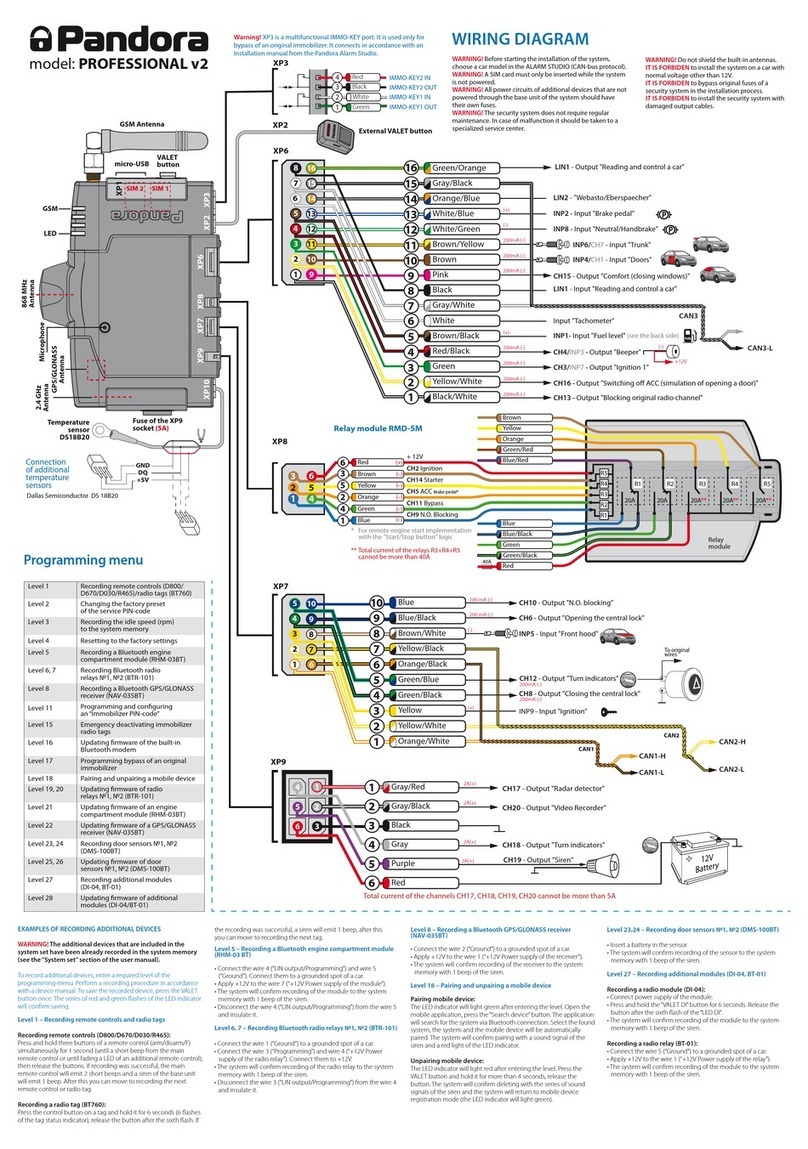
Pandora
Pandora Professional v2 manual

Python
Python 460HP installation guide

Steel mate
Steel mate 888 user manual
